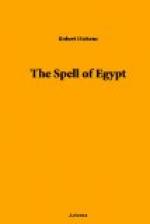This delicate cheerfulness, a quite airy gaiety of life, is often combined in Egypt, and most beautifully and happily combined, with tremendous solidity, heavy impressiveness, a hugeness that is well-nigh tragic; and it supplies a relief to eye, to mind, to soul, that is sweet and refreshing as the trickle of a tarantella from a reed flute heard under the shadows of a temple of Hercules. Life showers us with contrasts. Art, which gives to us a second and a more withdrawn life, opening to us a door through which we pass to our dreams, may well imitate life in this.
IV
ABYDOS
Through a long and golden noontide, and on into an afternoon whose opulence of warmth and light it seemed could never wane, I sat alone, or wandered gently quite alone, in the Temple of Seti I. at Abydos. Here again I was in a place of the dead. In Egypt one ever seeks the dead in the sunshine, black vaults in the land of the gold. But here in Abydos I was accompanied by whiteness. The general effect of Seti’s mighty temple is that it is a white temple when seen in full sunshine and beneath a sky of blinding blue. In an arid place it stands, just beyond an Egyptian village that is a maze of dust, of children, of animals, and flies. The last blind houses of the village, brown as brown paper, confront it on a mound, and as I came toward it a girl-child swathed in purple with ear-rings, and a twist of orange handkerchief above her eyes, full of cloud and fire, leaned from a roof, sinuously as a young snake, to watch me. On each side, descending, were white, ruined walls, stretched out like defaced white arms of the temple to receive me. I stood still for a moment and looked at the narrow, severely simple doorway, at the twelve broken columns advanced on either side, white and greyish white with their right angles, their once painted figures now almost wholly colorless.




